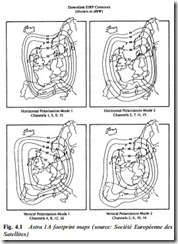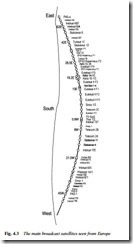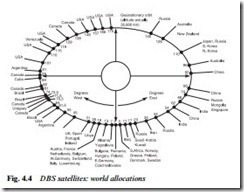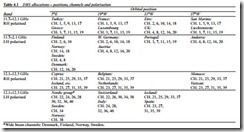SATELLITE TELEVISION
TV FROM SPACE
The concept of modern communications satellites was first put forward by Arthur C. Clarke in 1945, and first implemented in 1965 by Early Bird, built and launched in the USA. It is based on the use of a geosynchronous orbit in the plane of the equator, wherein the satellite orbits at an altitude of 36 000 km at a speed of 11 000 km/ h. Under these circumstances it appears stationary to an observer on earth, and can act as a ‘mirror in the sky’ to radio waves. The sky- path 36 000 km above the equator is called the Clarke belt and individual spots on it are known as orbital slots. These slots are defined and allocated by international agreement. The governing body for satellite slot allocation is the World Administrative Radio Conference (WARC), whose allocations are given in Table 4.1 and channel frequencies in Table 4.2.
The satellites are powered, for both transmission and internal housekeeping’ services, by solar energy, intercepted by banks of solar cells on dragonfly-type wings which are kept facing the sun. Transmissions to and from the satellite are in the Ku band, 10.95–14.5 GHz, concentrated into very narrow (and thus intense) beams by parabolic reflectors – dishes – at each end. Medium-power satellites like Astra 1A and 1B typically have transponder powers of 45 W, receivable with a dish of about 60 cm diameter in the primary service area. The DBS transmissions have higher power (say 100 W per transponder) and call for an antenna of about 35 cm diameter in the primary service area, centred on the receiving footprint. Typical footprint diagrams are given in Fig. 4.1.
A medium-power satellite typically has 16 transponders, whose footprints are not necessarily the same: by special antenna arrangements spot beams can be designed to cover different areas on the earth. The higher-power DBS satellites have five or ten transponders. All analogue TV transmissions from satellites are frequency- modulated to take advantage of the f.m. system’s greater immunity from noise interference. The carrier wave from a satellite can be polarised in either linear or circular fashion. The polarisation characteristic is used to discriminate between co-channels or adjacent
channels: interfering carriers in the wrong polar field are rejected by up to 22 dB, enabling the carriers from individual transponders on a single satellite to overlap without mutual interference. Fig. 4.2 shows the ‘staggered’ arrangement of carriers on a typical set of transponders.
Most satellite channels are 27 MHz wide; the Eutelsat II transpond- ers are an exception at 36 MHz. The f.m. transmissions carry an energy-dispersal waveform which prevents the carrier frequency
dwelling at one spot during such repetitive picture features as black- level, syncs and peak white: this avoidance of spot-frequencies lessens the risk of interference to other services.
The orbital slots in the Clarke belt of interest to European viewers are shown in Fig. 4.3. At present the most popular of these for direct- to-home services is the Astra group at 19.2°E. A single receiving antenna/dish can be fixed to a polar mount and made to scan the entire Clarke belt by manual or automatic (governed by the receiver’s microprocessor control system) means, but polar installations are not nearly so popular as simple, inexpensive fixed-dish outfits. World allocations for DBS satellite positions are the subject of Fig. 4.4.
Many satellite picture transmissions are scrambled or encrypted to prevent unauthorised viewing, generally by those who have paid no subscription, or by those who live in areas for which copyright release has not been obtained for the broadcast material. Many different scrambling systems are in use, some of which have to be frequently updated to keep ahead of the designers of ‘pirate’ decoders. Authorised decoders typically use a ‘smart-card’ containing data which, with the descrambling information carried in the broadcast itself, provides clear reception.
The MAC system was the only analogue one which was designed specifically for use with satellites, and gives far superior results to other systems. Non-MAC satellite transmissions, scrambled or not, use the same basic TV system as the terrestrial transmissions in the country for which they are intended, which generally means PAL/ 625 for Western Europe, Secam/625 for Eastern Europe and parts of the Middle East, and NTSC/525 for North America and Japan. The use of established colour-encoding systems is far from ideal for satellite use with frequency modulation, but confers compatibility with
existing TV equipment in the home, a compromise which most view- ers seem very ready to accept.
Again excepting the MAC transmissions, sound is broadcast on f.m. carriers typically spaced 6.5 MHz above the vision carrier. Stereo sound, using an analogue modulation format and a noise-reduction artifice such as the Wegener-Panda system, is used, and certain programmes offer bi-lingual sound channels. For these ‘audio extras’, narrowband sound carriers are used: in Astra transmissions they sit 7.02, 7.20, 7.38 and 7.56 MHz above the demodulated vision carrier. The audio signals on these carriers are not necessarily related to the video images on whose backs they ride; specialised and general ‘radio’ stations occupy them in some transponders. Digital radio transmissions are also present on some of the transponders: more details later in this chapter.
This plethora of transmissions, sound and vision, from the sky is uplinked from control/relay stations on Earth, using frequencies in the region of 14 GHz to convey not only programme signals, but also control, monitoring and telemetry commands and feedback. Thus is the satellite kept in position and on target.
In this chapter we shall examine analogue satellite systems. Digital ones will be covered in Chapter 12.





